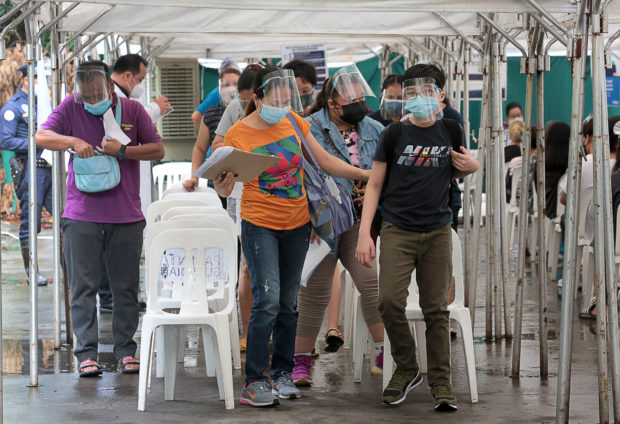New COVID-19 cases plunge below 7,000

MINORS’ TURN Teenagers queue with their parents at Pasig City General Hospital in Pasig City on Friday as part of the pilot run for the vaccination of minors. —GRIG C. MONTEGRANDE
MANILA, Philippines — The Department of Health (DOH) reported 6,913 new COVID-19 cases on Sunday, the lowest daily recorded cases since Aug. 3, bringing the total tally to 2,720,368.
But 95 more people succumbed to the coronavirus disease, including 31 people who were previously tagged as recovered. This raised the country’s COVID-19 death toll to 40,675.
While 10,237 more people were declared recovered after their two-week quarantine, a total of 81,641 people were still afflicted with the disease.
The majority or 82 percent of the active cases are mild, 5.5 percent asymptomatic, 7.13 percent moderate, 3.8 percent severe and 1.6 percent critical.
The DOH said out of 53,669 people who were tested on Oct. 15, 12.5 percent were confirmed to be infected. This positivity rate was the lowest since July 25.
Article continues after this advertisementThree laboratories, however, did not submit their results.
Article continues after this advertisementIntensive care unit bed occupancy nationwide has eased to moderate risk of 62 percent, and to a safe level of 59 percent in Metro Manila.
As this developed, the Inter-Agency Task Force for the Management of Emerging Infectious Diseases has placed Bulacan, Apayao, and Capiz on general community quarantine (GCQ) starting on Oct. 18 to Oct. 31.
Presidential spokesperson Harry Roque relayed the new classifications for the three provinces on Sunday.
Bulacan and Apayao were initially placed on modified enhanced community quarantine while Capiz was initially placed on GCQ with heightened restrictions.
‘Mobile vaccination’
Meanwhile, a lawmaker on Sunday said the government should deploy “mobile vaccination services” to bring COVID-19 shots closer to the hard-to-reach and high-risk population in the country.
Surigao del Sur Rep. Johnny Pimentel said many Filipinos had not received their COVID-19 shots due to barriers that have prevented them from accessing vaccination services.
Pimentel said there were Filipinos who could not access vaccination services due to lack of public transportation or due to family care or work schedules.
“The government has to reach out to these Filipinos with transportable vaccination teams,” he said in a statement.
According to Pimentel, mobile inoculation services will enable the government to reach Filipinos who remain unvaccinated because of their social and economic situations.
He pointed out that many of the unvaccinated Filipinos could not go to fixed vaccination sites because they were looking after children, the elderly, or persons with disabilities.
“We have to make it convenient for these Filipinos to access vaccination services,” he said.
While the government plans to fully vaccinate 77 million Filipinos by year-end to achieve herd immunity, he said only about 24 million Filipinos had been fully vaccinated.
Data from the National Task Force Against COVID-19 showed that 23.98 million Filipinos or 31.09 percent of the target population had been fully vaccinated in the country as of Oct. 14.
Last week, the House of Representatives allocated in the 2022 national budget a P20- billion fund for the procurement of COVID-19 vaccines and booster shots.
The House also approved another P45 billion in unprogrammed appropriations in the budget for the procurement of COVID-19 booster shots next year. INQ
For more news about the novel coronavirus click here.
What you need to know about Coronavirus.
For more information on COVID-19, call the DOH Hotline: (02) 86517800 local 1149/1150.
The Inquirer Foundation supports our healthcare frontliners and is still accepting cash donations to be deposited at Banco de Oro (BDO) current account #007960018860 or donate through PayMaya using this link.